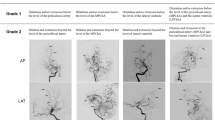Abstract
The Japan Adult Moyamoya (JAM) Trial was a unique randomized controlled trial demonstrating the effectiveness of direct bypass surgery for hemorrhagic moyamoya disease. Prespecified subgroup analysis undertaken as part of the trial demonstrated that posterior-dominant initial hemorrhage is a significant predictor of rebleeding and an effect modifier for surgery. Periventricular anastomosis—fragile collaterals formed by the lenticulostriate arteries, thalamic perforators, and choroidal arteries—might present a clue to the mechanism of high rebleeding risk linked to posterior hemorrhage. Angiographic analyses of the JAM Trial revealed that choroidal collaterals and the involvement of the posterior cerebral artery are associated with posterior hemorrhage, and subsequent cohort analysis of the nonsurgical group has revealed that choroidal anastomosis is a strong predictor of rebleeding. A better understanding of periventricular anastomosis might contribute to further progress in the surgical treatment of hemorrhagic moyamoya disease.
Access this chapter
Tax calculation will be finalised at checkout
Purchases are for personal use only
Similar content being viewed by others
References
Kobayashi E, Saeki N, Oishi H, Hirai S, Yamaura A. Long-term natural history of hemorrhagic moyamoya disease in 42 patients. J Neurosurg. 2000;93(6):976–80. https://doi.org/10.3171/jns.2000.93.6.0976.
Houkin K, Kamiyama H, Abe H, Takahashi A, Kuroda S. Surgical therapy for adult moyamoya disease. Can surgical revascularization prevent the recurrence of intracerebral hemorrhage? Stroke. 1996;27(8):1342–6.
Miyamoto S, Yoshimoto T, Hashimoto N, Okada Y, Tsuji I, Tominaga T, et al. Effects of extracranial-intracranial bypass for patients with hemorrhagic moyamoya disease: results of the Japan adult moyamoya trial. Stroke. 2014;45(5):1415–21. https://doi.org/10.1161/strokeaha.113.004386.
Miyamoto S. Study design for a prospective randomized trial of extracranial-intracranial bypass surgery for adults with moyamoya disease and hemorrhagic onset-the Japan Adult Moyamoya Trial Group. Neurol Med Chir (Tokyo). 2004;44(4):218–9.
Takahashi JC, Funaki T, Houkin K, Inoue T, Ogasawara K, Nakagawara J, et al. Significance of the hemorrhagic site for recurrent bleeding: prespecified analysis in the Japan adult moyamoya trial. Stroke. 2016;47(1):37–43. https://doi.org/10.1161/strokeaha.115.010819.
Kawaguchi S, Sakaki T, Kakizaki T, Kamada K, Shimomura T, Iwanaga H. Clinical features of the haemorrhage type moyamoya disease based on 31 cases. Acta Neurochir. 1996;138(10):1200–10.
Morioka M, Hamada J, Kawano T, Todaka T, Yano S, Kai Y, et al. Angiographic dilatation and branch extension of the anterior choroidal and posterior communicating arteries are predictors of hemorrhage in adult moyamoya patients. Stroke. 2003;34(1):90–5.
Funaki T, Takahashi JC, Yoshida K, Takagi Y, Fushimi Y, Kikuchi T, et al. Periventricular anastomosis in moyamoya disease: detecting fragile collateral vessels with MR angiography. J Neurosurg. 2016;124(6):1766–72. https://doi.org/10.3171/2015.6.jns15845.
Funaki T, Fushimi Y, Takahashi JC, Takagi Y, Araki Y, Yoshida K, et al. Visualization of periventricular collaterals in moyamoya disease with flow-sensitive black-blood magnetic resonance angiography: preliminary experience. Neurol Med Chir (Tokyo). 2015;55(3):204–9. https://doi.org/10.2176/nmc.oa.2014-0360.
Van den Bergh R. The ventriculofugal arteries. AJNR Am J Neuroradiol. 1992;13(1):413–5.
Marinkovic S, Gibo H, Filipovic B, Dulejic V, Piscevic I. Microanatomy of the subependymal arteries of the lateral ventricle. Surg Neurol. 2005;63(5):451–8.; discussion 8. https://doi.org/10.1016/j.surneu.2004.06.013.
De Reuck J. The human periventricular arterial blood supply and the anatomy of cerebral infarctions. Eur Neurol. 1971;5(6):321–34.
Kodama N, Suzuki J. Cerebrovascular moyamoya disease IIIrd report-the study on the aging of the perforating branches and the possibility of collateral pathway. Neurol Med Chir Part I. 1974;14(1):55–67. https://doi.org/10.2176/nmc.14pt1.SUPPLEMENT_55.
Funaki T, Takahashi JC, Houkin K, Kuroda S, Takeuchi S, Fujimura M, et al. High rebleeding risk associated with choroidal collateral vessels in hemorrhagic moyamoya disease: analysis of a nonsurgical cohort in the Japan adult Moyamoya trial. J Neurosurg. 2019;130(2):525–30. https://doi.org/10.3171/2017.9.jns17576.
Funaki T, Takahashi JC, Houkin K, Kuroda S, Takeuchi S, Fujimura M, et al. Angiographic features of hemorrhagic moyamoya disease with high recurrence risk: a supplementary analysis of the Japan adult Moyamoya trial. J Neurosurg. 2018;128(3):777–84. https://doi.org/10.3171/2016.11.jns161650.
Fujimura M, Funaki T, Houkin K, Takahashi JC, Kuroda S, Tomata Y, et al. Intrinsic development of choroidal and thalamic collaterals in hemorrhagic-onset moyamoya disease: case-control study of the Japan adult Moyamoya trial. J Neurosurg. 2018;130(5):1453–9. https://doi.org/10.3171/2017.11.Jns171990.
Miyakoshi A, Funaki T, Takahashi JC, Takagi Y, Kikuchi T, Yoshida K, et al. Restoration of periventricular vasculature after direct bypass for moyamoya disease: intra-individual comparison. Acta Neurochir. 2019;161(5):947–54. https://doi.org/10.1007/s00701-019-03866-9.
Miyakoshi A, Funaki T, Fushimi Y, Nakae T, Okawa M, Kikuchi T, et al. Cortical distribution of fragile periventricular anastomotic collateral vessels in moyamoya disease: an exploratory cross-sectional study on Japanese moyamoya patients. Am J Neuroradiol. 2020:5. https://doi.org/10.3174/ajnr.A6861. [Epub ahead of print]
Funaki T, Kataoka H, Yoshida K, Kikuchi T, Mineharu Y, Okawa M, et al. The targeted bypass strategy for preventing hemorrhage in moyamoya disease: technical note. Neurol Med Chir (Tokyo). 2019;59(12):517–22. https://doi.org/10.2176/nmc.tn.2019-0162.
Funaki T, Takahashi JC, Houkin K, Kuroda S, Fujimura M, Tomata Y, et al. Effect of choroidal collateral vessels on de novo hemorrhage in moyamoya disease: analysis of nonhemorrhagic hemispheres in the Japan adult moyamoya trial. J Neurosurg. 2019;132(2):408–14. https://doi.org/10.3171/2018.10.Jns181139.
Takahashi JC, Funaki T, Houkin K, Kuroda S, Fujimura M, Tomata Y, et al. Impact of cortical hemodynamic failure on both subsequent hemorrhagic stroke and effect of bypass surgery in hemorrhagic moyamoya disease: a supplementary analysis of the Japan adult Moyamoya trial. J Neurosurg. https://doi.org/10.3171/2020.1.Jns192392. [Epub ahead of print]
Author information
Authors and Affiliations
Consortia
Corresponding author
Editor information
Editors and Affiliations
Rights and permissions
Copyright information
© 2021 The Author(s), under exclusive license to Springer Nature Singapore Pte Ltd.
About this chapter
Cite this chapter
Funaki, T., Takahashi, J.C., Miyamoto, S., the JAM Trial Group. (2021). Hemorrhagic Stroke and the Japan Adult Moyamoya Trial. In: Kuroda, S. (eds) Moyamoya Disease: Current Knowledge and Future Perspectives. Springer, Singapore. https://doi.org/10.1007/978-981-33-6404-2_9
Download citation
DOI: https://doi.org/10.1007/978-981-33-6404-2_9
Published:
Publisher Name: Springer, Singapore
Print ISBN: 978-981-33-6403-5
Online ISBN: 978-981-33-6404-2
eBook Packages: MedicineMedicine (R0)




